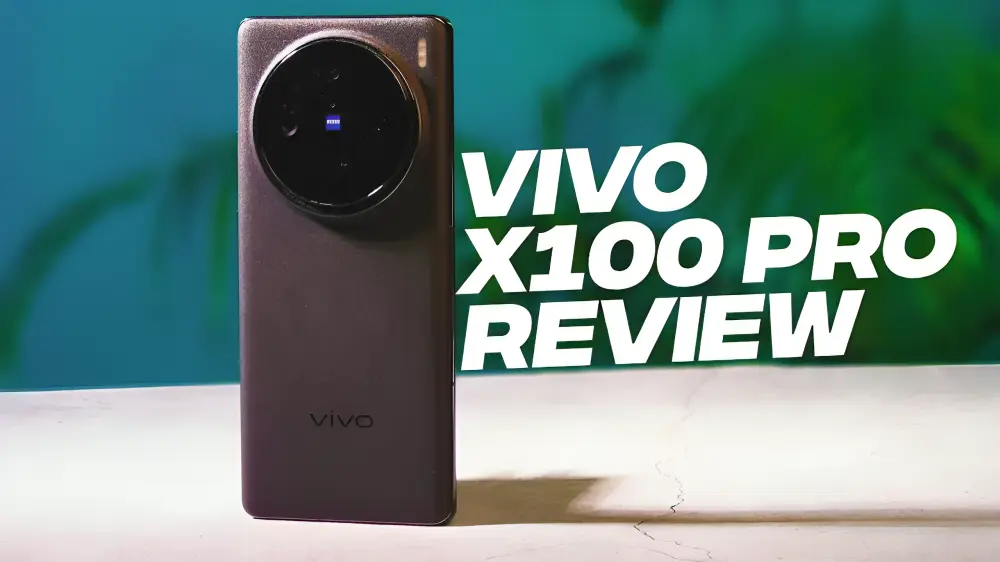Smartphones are becoming more than just a means of communication in today’s tech-obsessed society; they are our lifelines to the digital world and an extension of who we are. Manufacturers of smartphones try to surpass themselves every year by increasing the bar for creativity and design. Presenting the Vivo X100 Pro, the newest model from the well-known smartphone behemoth Vivo that aims to completely transform the smartphone experience. We explore in-depth what sets the Vivo X100 Pro review.
Vivo X100 Pro Review Overview
| Dimensions: | 164.1 x 75.3 x 8.9mm |
| Weight: | 221g |
| Screen: | 6.78-inch 20:9 HD (2800×1260) 120Hz AMOLED |
| Chipset: | Mediatek Dimensity 9300 |
| RAM: | 16GB |
| Storage: | 512GB |
| OS: | Android 14 w/ Funtouch 14 |
| Primary camera: | 50MP, f/1.8 |
| Zoom camera: | 50MP f/2.5, 4.3x optical & 100x digital zoom |
| Ultra-wide camera | 50MP f/2.0 119-degree |
| Front camera: | 32MP f/2.0 |
| Audio: | Stereo speakers |
| Battery: | 5,400mAh |
| Charging: | 100W wired, 50W wireless |
| Colors: | Startrail Blue, Asteroid Black, Sunset Orange |
Price and Availability
Following its late January 2024 launch, the Vivo X100 Pro was gradually released in Europe and India in the months that followed. We don’t anticipate the phone being released in the US based on experience, as Vivo typically doesn’t sell its technology there.
As of this writing, no price for the UK has been confirmed, but in Europe, the 16GB RAM and 512GB storage model costs €1,199, which is equivalent to about $1,300 / £1,020 / AU$1,990. This is a high-end phone for those seeking the best specifications. While there are a few other models available in China, Vivo appears to be promoting the 16GB/512GB model as the main model in Europe.
Vivo X100 Pro Review: Design and Build
As is customary with Vivo devices, “Professional Photography” continues to run across the top of the gadget, and the Zeiss logo is positioned exactly in the center of the back camera module. There are several reasons why the rear camera array is different from the previous X90 Pro, not the least of which is the inclusion of a Type 1.0-inch image sensor for the primary lens. The additional space required to fit everything in is also a result of changes made to the other lenses, but the X100 Pro currently looks more like the Xiaomi flagships that have been making the rounds lately.
The 6.78-inch AMOLED screen on it has the same resolution (2800 x 1260), peak brightness (1300 nits), and adaptive 1-120Hz refresh rate as the previous X90 Pro. Regrettably, this also means that curved edges are returning. However, you can counter this by using the silicone case that comes with the device, which gives the sides some grip for easier handling when taking pictures.
Except for ditching the vegan leather back in favor of a matte finish that glitters in direct sunlight, Vivo essentially left the design mostly unchanged. The X100 Pro is only slightly heavier than its predecessor, but it still has the same measurements and positioning, giving it a very familiar feel across generations. For added durability, it also features IP68 protection and wireless charging capabilities.
Camera Features
For its primary 50-megapixel wide camera (23mm equivalent), Vivo is reintroducing the Type 1 (13.1 x 9.8mm) Sony IMX989 sensor, which features an f/1.8 aperture, optical image stabilization, dual pixel and laser autofocus, and 1.6µm pixels. The primary lens is identical to the X90 Pro on paper, right down to the pixel binning that automatically captures images at 12.5 megapixels. You would need to use High-Resolution mode to get full resolution.
The telephoto lens, a 50-megapixel OmniVision OV64B image sensor with an f/2.5 aperture and 4.3x optical zoom (equivalent to 100mm), is where things start to diverge. But there’s a little catch to this. Although the actual imaging area used by Vivo is more akin to a 1/2.51-inch, the company still claims that the sensor is a 1/2.0-inch.
There could be a good reason for this. Since the OV64B typically has a 64-megapixel sensor, the crop factor and sensor center line up, at least in phones that use it. It is also a component of a Zeiss floating elements design and periscope system, which allows for steadier focusing at both longer and shorter distances. When you get it close enough to a subject, macro mode activates.
Battery Life
With a 5,000mAh battery being the most commonly used, the 5,400mAh battery on the Vivo X100 Pro is one of the largest power packs we’ve seen on a smartphone. It’s also necessary because the Vivo consumes a lot of power due to its large 120Hz display, 5G connectivity, and potent chipset. Fortunately, the large chipset allows the phone to function well enough for a full day of use before requiring a recharge.
When the time comes to charge the phone, it does so quickly thanks to wired charging, which uses a scorching 100W and can fill your phone up from empty to full in less than 30 minutes with a compatible cable. 50W wireless charging is very quick for this kind of transmission, once more.
In addition, reverse wired charging allows you to use the Vivo as a power bank by plugging in another device. This is more dependable (and much faster) than reverse wireless charging, so I found it useful for charging headphones on the go. All you need is a USB-C cable to connect to whatever device your second device needs.
Software Features
As of this writing, Google’s most recent version of its mobile operating system is Android 14, but Vivo has guaranteed that the X100 Pro will receive updates for three years. While other Android brands promise five or more years, some may view that as a low estimate; however, for most people who don’t closely monitor tech news, three years should be plenty.
Except for a new 4K Cinematic Portrait video mode that allows you to alter bokeh, apply LUTs, and—in a somewhat unsettling way—adjust beauty settings, Vivo offers the same shooting modes as before. Even though this mode lacks the Zeiss bokeh effects from previous ones, the LUTs and styling are unmistakably German brand-sourced, making the mode an effective Zeiss creation overall. Once taken, you can adjust the portrait effect in Albums at a later time.
For still images, there is Snapshot, which is one of my personal favorites since it concentrates on stopping motion. The drawback is that, particularly when zooming at 2x or 4.3x, it frequently increases ISO to make up for the faster shutter speeds it uses. Snapshot essentially takes the place of the previous Sports mode, which is now more appropriately named as it covers all movements rather than just those associated with sporting events.
Performance and Audio
This phone, which is excellent for gaming, has the same Dimensity 9300 chipset as the Oppo Find X7. Together with 512GB of storage and 16GB of RAM, that offers an abundance of capacity and power. Though given how much is included, it’s not the end of the world that there isn’t expandable storage.
The phone achieved a multi-core score of 7,292 in a Geekbench 6 benchmarking test, which blows away the Samsung Galaxy S23 Ultra in Geekbench’s official rankings (which are currently at 5,244, with the Galaxy S24 Ultra not listed as of this writing). All in all, this phone is incredibly powerful.
In addition to testing several other games like Northgard, PUBG Mobile, and Ronin, I spent a long time playing Call of Duty: Mobile. There were no instances of lagging in any of the games, all of which had excellent graphic options and high frame rates.
As previously mentioned, there is no 3.5mm headphone jack for audio. You can play music loudly or connect via the pleasant and dependable Bluetooth 5.4 standard. The two speakers work well for voice messages and playing games, but if you want high-quality audio for streaming movies or music, get the best wireless headphones.
Conclusion
The Vivo X100 Pro review is evidence of Vivo’s dedication to design brilliance and innovation. It provides a high-end smartphone experience with its state-of-the-art features, such as the 120Hz AMOLED display, potent Dimensity 9300 chipset, and outstanding camera system. It’s a worthwhile purchase for those looking for premium performance and functionality in a stylish package, even with its high price tag.





